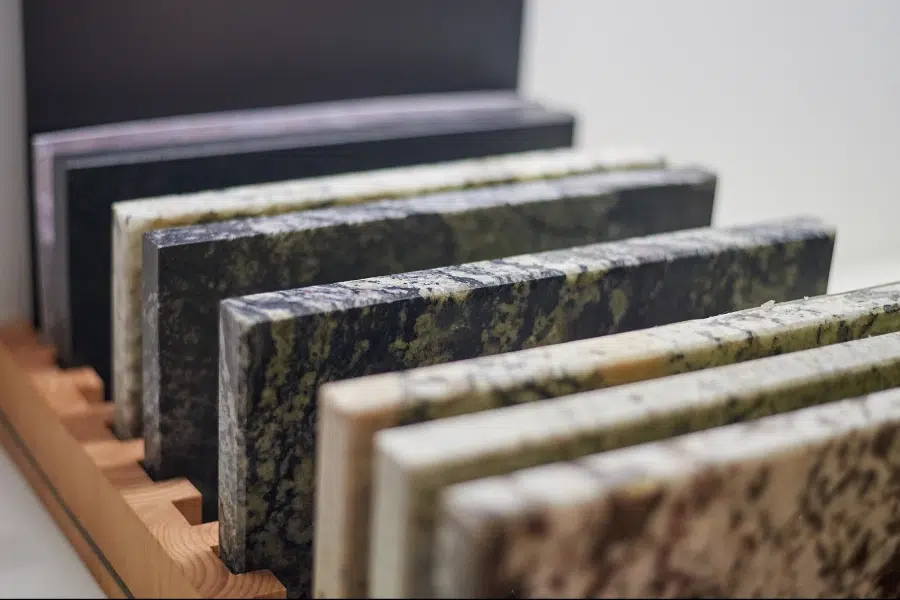Carrara Marble Vs. Calacatta Marble – What’s The Difference?
- Carrara Marble: Carrara Marble is an exceptionally strong and long-lasting kind of marble. Its durability makes it a good option for a wide variety of business and domestic uses. Carrara Marble is beautiful and durable, but it may be stained or scratched if not cared for correctly. It may be used in a variety of settings thanks to its resilience, but its aesthetic value should be protected at all costs.
- Calacatta Marble: The durability of Calacatta Marble is typically compared to, if not exceeded by, that of Carrara Marble. Because of its compact composition and low porosity, it resists staining and etching. This marble is suitable for heavy foot activity and will retain its brilliance even after regular usage. Its durability and resilience make it a top choice among people shopping for marble.

Find the Perfect Stone for
Your Project
Not sure which stone will suit your kitchen, bathroom, or outdoor space? Explore our curated selection of natural stone slabs and get expert advice on the best choice for your design.
Carrara marble and Calacatta marble Slabs have both been used in a variety of building and decorating projects. Here is a typical use of them:
- Carrara Marble: Carrara Marble is often utilized in bathrooms, kitchens, and flooring due to its mellow gray tones and fine veining. Its understated beauty makes it a popular choice for kitchen and bathroom surfaces as well as for wall covering. Because of its traditional good looks, Carrara marble has long been a favorite material of interior decorators and homeowners.
- Calacatta Marble: The striking veining and color variations of Calacatta Marble make it a focal point. It is often seen in opulent places like hotel lobbies, gourmet kitchens, and impressive front entrances. Because of its eye-catching design, it may be used inside or out to create a statement.
Maintenance and Care
- Carrara Marble: Regular sealing of Carrara Marble is necessary to protect it from stains and etching. To protect the surface, it’s best to clean it gently with a neutral-pH cleanser. Cleaning products with acid or abrasives should be avoided, since they will dull the marble’s polish. It may be kept looking shiny and elegant with regular polishing.
- Calacatta Marble: Calacatta Marble requires comparable upkeep as Carrara, however its reduced porosity may mean it needs sealing less often. To avoid costly repairs, always quickly clean up spills and protect surfaces with coasters or mats. Calacatta Marble, like Carrara, can be cared for and kept looking opulent with regular light washing and the occasional application of polish.
Patterns, Veins, and Shades
- Carrara Marble: Carrara marble is known for its homogeneous backdrop and fine, feathery veining. Its tones range from pale gray to cool blue, with nuanced shifts that provide a calming overall effect. Carrara marble’s subtle veining makes it a versatile material that can be used in both classic and modern settings.
- Calacatta Marble: On the other hand, Calacatta Marble stands out for its striking veining. On a white or creamy backdrop, the veins might be any shade from gold to brown to gray. Calacatta Marble is an excellent option for people who want to create a bold design statement due to its stunning patterns. Its ostentatious allure has come to symbolize wealth and power.
Conclusion
Frequently Asked Questions (FAQs)
What is the difference between Calacatta marble and Carrara marble?
Is Carrara or Calacatta more expensive?
Is Calacatta marble harder than Carrara?
Natural Stone Slab Supplier
Avant Stone brings together 20 years of stone industry experience to provide you with a range of globally sourced stone slabs including Marble slabs, Granite slabs and Quartzite Slabs.
We aim provide you quality service and distinctive stone products for your home or your commercial space. Avant Stone is the premier Stone Supplier of Granite, Quartzite and Marble slabs in Sydney.
Our showroom is located centrally in Greenacre, a mere 20 minutes from Sydney & Parramatta CBD.
Give us a call: 0298170037
Email us at: info@avantstone.com.au



